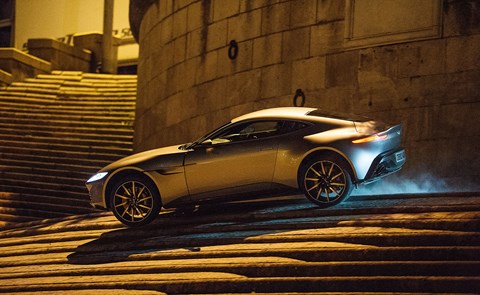► Bond 24 – Spectre in cinemas soon
► Aston Martin DB10 and Jaguar C-X75
► Ben Oliver looks behind the scenes
We don’t have a British Motor Show anymore, but we do have the Bond films. And apart from being the biggest blockbuster film franchise on earth, these movies provide an unparalleled shop window for British cars. As Bond 24 – Spectre – opens in cinemas, with its cast of Aston Martins, Jaguars and Land Rovers, Ben Oliver uncovers the power of 007 to make British cars sexy for an audience of billions…
The Franshise
It’s often asserted (but never proven) that half the world has seen a Bond film. It might well be true. Bond is the second most-lucrative movie franchise, behind Harry Potter but ahead of Star Wars, having taken more than $6 billion at the box office. Yes, it has earned that figure over more time (53 years) and films (23, not including Spectre) than any other major franchise, but the size of the Bond back-catalogue and its easy availability on late-night TV and bootleg DVDs mean that audience claim might just be true.
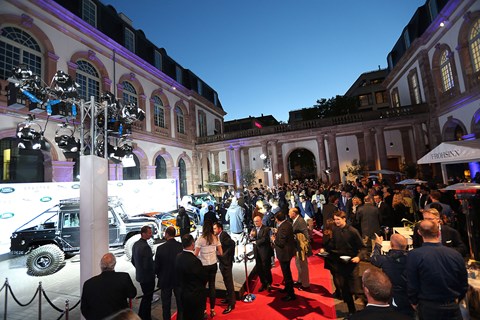
The real Bond HQ isn’t the MI6 building in Vauxhall but an anonymous office on Piccadilly, home to Eon Productions, which has owned the film rights to Bond since 1961. It only makes Bond films. It guards its ‘golden goose’ with Secret Service severity, and decides which cars get to star. Like its hero, the Bond franchise doesn’t seem to be losing its allure with time. Skyfall was the first Bond film to make over a billion dollars and is the 12th highest-grossing film of all time, although if you adjust for inflation both Goldfinger and Thunderball made similar sums.
The deals
Bond’s creator Ian Fleming name-checked Bentley and Aston Martin (and Rolex and Dunhill) in his original novels and short stories. His famously demanding, discerning hero was defined partly by what he chose to drive, use and wear, which makes the rampant commercialism of the Bond franchise slightly easier to stomach. The first paid-for Bond car cameo came in 1974 when defunct US manufacturer AMC paid $5m for its crappy cars to feature in The Man With The Golden Gun, despite the fact that they weren’t sold in Thailand, where their scenes were set. BMW did a three-picture deal with Eon starting with 1995’s GoldenEye, and made a major contribution to the $100m which ’97’s Tomorrow Never Dies raised in product placement, funding almost its entire production budget. Ford took over in 2002, paying an estimated $35m for its brands – including Aston Martin – to star in Die Another Day, nicknamed Buy Another Day for the scale and lack of subtlety of its commercial deals. These deals don’t always involve simply writing Eon a giant cheque: some or all of the payment comes in the huge sums the brands guarantee to spend marketing the film, which saves Eon doing any advertising. But they don’t always work. Heineken’s $45m deal to appear in Skyfall was probably the single biggest in Bond history, but after half a century of vodka-Martinis it just looked exploitative even to Bond fans, and there was a campaign to boo every Heineken appearance in the film. Eon will need a big cheque to swap Bond’s Aston for a Geely.
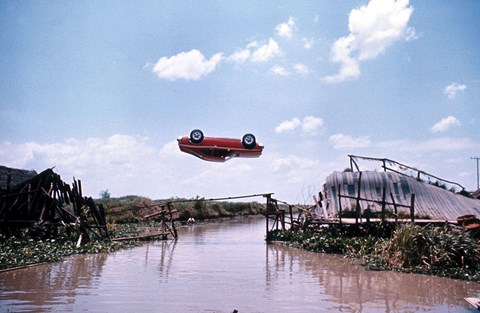
Bond and Aston
The most famous, long-lasting and authentic product placement in movie history nearly never happened. In his original novels, Ian Fleming gives Bond a vintage Bentley. But in the Goldfinger novel, first published in 1959, Bond borrows an Aston Martin DB3 from the Secret Service fleet in ‘an inconspicuous colour – battleship grey – and (with) certain extras which might or might not come in handy’. Bond producer Albert ‘Cubby’ Broccoli approached Aston’s owner David Brown to borrow two of his then-new DB5s for the film, but in the polar opposite of today’s big-money placement deals Brown demanded a large payment for the rights to use his car. A wiser head told him that it might be a good idea and he grudgingly relented.
This half-century relationship was forged in less than 15 minutes of screen time. In Goldfinger, the DB5 is done with by the 47th minute, and in Thunderball its role is confined largely to the pre-title sequence. But they were two of the most successful Bond films, and the effect on the firm’s fortunes continues. Aston sales leapt by 60% in the second half of the ’60s. Equally, Corgi’s famous die-cast model of Bond’s DB5 became the fastest-selling ‘car’ of all time, shipping 2.5m in its first year and six million in total. Then, as now, the benefit of Bond to Aston is in its creation of the desire to buy one, even if you don’t yet have a driving licence, much less the funds. That equity has probably saved Aston at least once. Like Bond, it has had regular near-death experiences and the value of the Bond association has probably made the difference between life and death in several of its seven bankruptcies. Bond has been saved by his Aston, and he has almost certainly returned the favour.
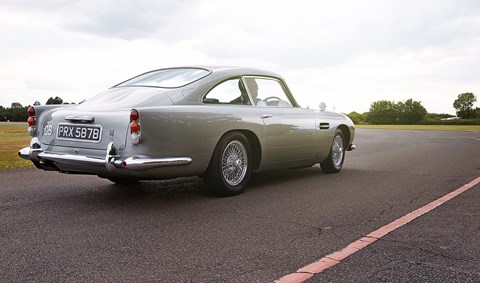
The DB10
‘Barbara Broccoli and Michael Wilson (the film’s producers) got in touch and said that they’d love us to be in the next movie,’ Aston’s chief creative officer, Marek Reichman, tells CAR.
‘So we brought them and Sam (director Sam Mendes) into the design studio and showed them our future cars. That’s how close the relationship is. As I was showing them a car that comes out next year, Sam looked to one side and spotted a sketch on the wall. He asked me about it. I explained that it was an idea for a car that we hadn’t developed yet. “I love it,” he said. “Can we do that?”
‘We then started to talk about how iconic this product could be if we designed it just for Bond. In a recent poll the DB5 is the first car people associate with Great Britain. It’s gone beyond just car iconography: it’s part of the iconography of this country now. We thought it would be amazing to replicate that for the next generation of moviegoers and fans. So we decided, okay, for the first time in our history we will develop a car just for Bond.’
With the entire Aston range about to be replaced it made little sense to put Bond in an existing model, but it gave Reichman and his team just five months between that first meeting and the first cars being delivered for filming. So although the DB10’s exterior is unique and hints at Aston’s new design language, the ten cars required for filming were hand-built on the Vantage chassis by Aston Martin’s ‘Q’ bespoke division, named with neat circularity after Desmond Llewellyn’s Secret Service scientist who creates Bond’s cars and gadgets.
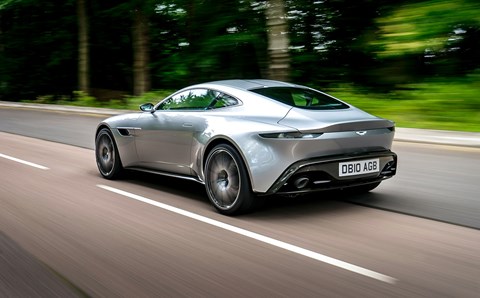
So if the DB10 hints at future Aston Martins, what should we be paying attention to? ‘Look for the simplicity of its body sides and the fact that the car has this appearance of downward motion,’ says Reichman. ‘The waistline actually has a falling line, so the car has an amazing drama through its side section, which is very pure, very simple.
‘Then if you look at the front, it’s a shark. I wanted the car to be a predator, just as Bond is a predator. Bond is someone who is very attractive to look at, but he’s also very menacing, and I wanted the car to have a similar feel. Sharks are beautiful things to look at, but do I want to be dangling my legs in the water with them? Certainly not.
‘And finally there are all of the beautiful highlight details that you’ll see so well on screen because of how Sam has lit the car.’
But what you really want to know about is the gadgets. ‘All I’ll say is that in terms of excitement and the unexpected, this car has everything,’ he says. ‘We all remember those great scenes in the early Bond movies. There’s a little bit more seriousness in the recent movies, but this one has some unexpected gadgets, and brings back some that we all love. Yeah, without saying any more about it, the gadgets are great.’
The bad guys
Jaguar Land Rover’s formal relationship with Bond goes back to 2002, when parent company Ford paid its way in, and villain Zao drove a rather camply modified XKR. Now independent and riotously successful, JLR could afford to pay for its cars to be included, but doesn’t need to. A sense of Britishness is as important to a Bond film as the stunts and the girls, and you can communicate that more clearly with the cars used than with the cut of his Savile Row suit. John Edwards is the director of JLR’s Special Vehicle Operations division which built the 22 cars supplied to Eon, including Range Rover Sport SVRs, special ops Defenders and seven C-X75s needed for the main chase sequence between villain Mr Hinx and Bond’s DB10 in Rome.
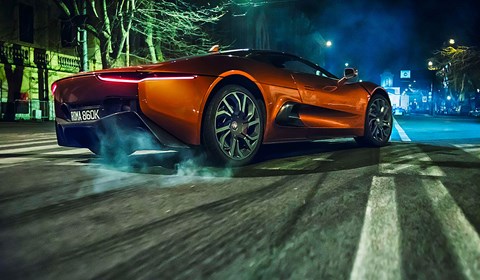
Two of the original C-X75 concept cars were used for static shots and the ‘dynamic’ cars were hand-built over a space-frame chassis and using the 550bhp supercharged V8 from the F-type. ‘I’m not sure what state they came back in,’ says Edwards. ‘I suspect they’ll be heading to a scrapyard soon.’ Edwards says that JLR didn’t pay to appear, but seems not to really know or care how much the project cost, or the value of the exposure Jaguar and Land Rover get in return. ‘I’m slightly sceptical of the accuracy of those values anyway. You just know how many people are going watch the film. You know it’s going to be a success. I think it’s a no-brainer.’
The impact
I know the cost of doing product placement,’ Aston’s CEO Andy Palmer tells me. ‘This isn’t product placement because we don’t pay for it, but if we had to, we couldn’t afford it. We still have to supply the cars and that’s a major commitment for a company of this size. Do I know what it costs us? Yes. Am I going to tell you? No. But it isn’t cheap. In a bigger company I could tell you the value of what we get in return, but those numbers are often bullshit anyway. But this helps us reach the kids. It broadens the very top of our sales funnel out to include billions of people. When you go to the Far East, and especially to China where we sell 200 cars a year and are virtually invisible on the road, everybody knows that we’re the car that Bond drives. And soon we’ll have models like the DBX that can capitalise on that. Is that worth £x million to us? I think so. It’s intuitive. This feels right.’
The Action
The DB10 and C-X75 had their moment when, for 17 days in March, the Bond second unit took over Rome to shoot the big car chase. If you think ‘taking over Rome’ is an exaggeration, consider this: the second unit comprised 350 people, augmented by a further 250 locally hired ‘blockers’, whose job it was to make sure locals didn’t wander innocently into shot. 4km of the River Tiber, including five bridges, were closed off, along with 15 other city locations. Most implausibly, a mile-long stretch of Via della Conciliazione was closed off to allow the chase cars to engage in a 100mph dice right in front of the Vatican.
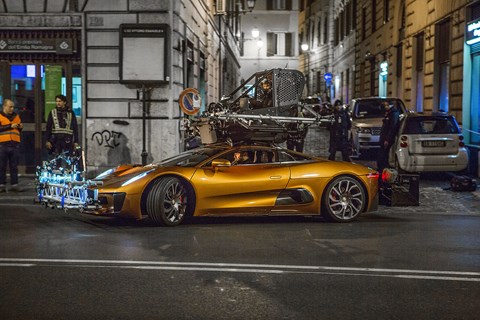
Eight of the 10 DB10s were on duty along with five of the Jags, each car having a specific purpose during filming. Two of the Astons are ‘pod cars’, featuring a roof-mounted cage with remote controls which allow stuntman Mark Higgins to drive while the actors are filmed in the cockpit. Two of the DB10s have no engine, battery or any fluids, this being a condition of them being allowed to operate next to the river, with the attendant possibility of ending up in the drink.
Three-times British rally champion Higgins doubles for Daniel Craig – Paul Smith suit, Omega watch and all – although the Alpinestars race boots give the game away. ‘The Aston’s incredibly strong,’ he tells CAR. ‘Driving it down the steps was tough on my back, but the car was fine. It needed sump guards and different suspension, that’s all. Carrying 100mph through Vatican Square sideways was certainly interesting. We did a lot of practice at Millbrook and MIRA but you can’t simulate wet cobbles.’
Isn’t it scary driving like a madman in precious cars on precious streets? ‘I’ve scared myself,’ admits Higgins. ‘But I can’t scare Daniel – he’s James Bond.’
